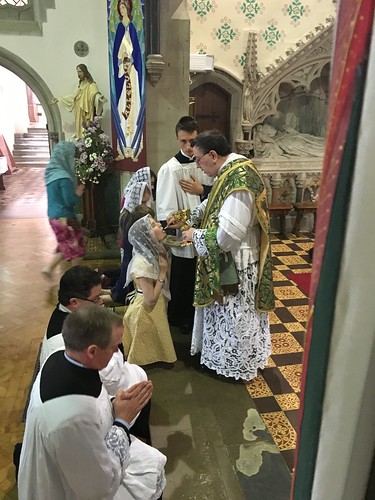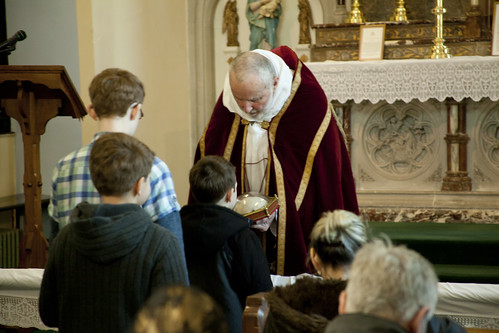Chairman's Blog
On Gossip and cults
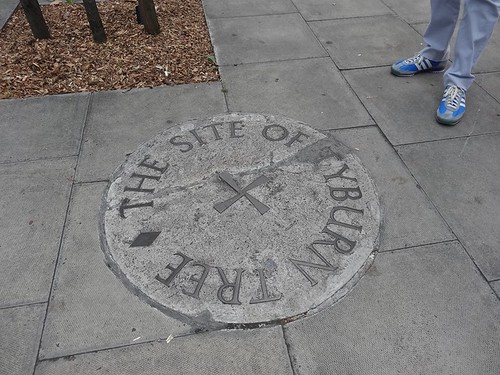 |
| Where 105 Catholics became victims of tyranny. |
This short passage in a book I'm reading struck me as worth sharing. The subject is cults--groups using psychological techniques to exploit their members for an ulterior goal (usually the enrichment of the founder).
In many groups, there is a "no gossip" or "no nattering" rule which keeps people from expressing their doubts or misgivings about what is going on. This rule is usually rationalized by saying that gossip will tear apart the fabric of the group or destroy unity, when in reality the rule is a mechanism to keep members from communicating anything other than positive endorsements.
M.T. Singer, Cults in Our Midst, pp69-70
Cults often defend themselves by pointing out superficial similarities with hierarchical and authoritarian organisations such as elite military units or traditional religious groups. This is one of the things which help one tell them apart. In the military, having the same things to complain about is actually one of the mechanisms by which recruits bond together as a unit; in cults care is taken to prevent communication, and the development of fellow-feeling, among them. I can't speak for other religions, but in the Catholic Church we are encouraged to 'manifest our concerns' not only up the chain of command--if we want to think in such terms--but horizontally. Canon 212: [the laity] have the right also to make their views known to others of Christ's faithful.
Reading about the horror of cults, whether religious, New Age, or based around get-rich-quick schemes or communication with Extra Terrestrials, makes me grateful for the things which prevent the Church from heading even a little in that direction. Another very important aspect is that all established religions have an objective tradition to which members can appeal, and against which the whims of their superiors can be judged and criticised. Religions which re-write their core texts, or let portions of them slip down the memory hole (or, even worse, don't have such texts), are treading a very dangerous path, because they are making the views of their current leaders the final court of appeal, not just in a disciplinary sense (which may be inevitable), but morally and rationally, for sincere members. At that point you are no longer struggling, with the help of the institutional leadership, to live a set of objective ideals, but are becoming the pawns, the playthings, of the leadership. This leadership may be benign, but isn't impeccable, and can easily, in the absence of constraints, become megalomaniacal, even if it didn't start that way.
Support the work of the LMS by becoming an 'Anniversary Supporter'.
Patriarchy, weediness, and neo-conservatism
Thinking about the ongoing debate on marriage, I thought I'd repost this, from Februrary 2016.
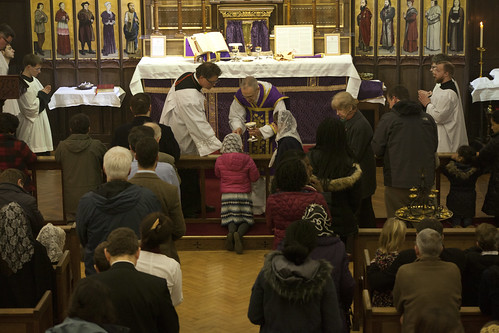 |
| Feed my sheep. |
Something I have mentioned a few times I can now make more explicit: what neo-conservatives have done to marriage.
Patriarchy involves rights and duties for both parties. Over the millennia, Christian and non-Christian versions of Patriarchy have given men the incentive necessary to get them to commit to spouse and family, that is, to provide their families with support and protection. Christian Patriarchy, taking inspiration from the mystical relationship between Christ and the Church, raises Patriarchy to a higher level, as grace builds upon nature, but the point of it, the incentive to men and the support and protection to women, remains. Grace builds on nature, it does not abolish nature. By connecting the traditional prerogative of authority to the authority of Christ, Christian Patriarchy tells us more about what that authority is for (the benefit of the family as a community), but emphasises even more that this authority is to be taken seriously.
Feminists and radical liberals are hostile to the very concept of the family, because the family passes on values without reference to the state, and totalitarians cannot tolerate this. But the conservatives of today have done something very strange as well. In response to the claim that Patriarchy is oppressive, their response has been: well ok, let's stress the duties of the husband to the wife, and the prerogatives of the wife over the husband, and ignore or even deny the duties of the wife to the husband, and the prerogatives of the husband over the wife.
Explicit denial of the authority of the husband over the wife can be found in neo-conservative online Catholic sources such as this and this; it is given at length in books like this. Such views are often linked to Christopher West, though I couldn't find a helpful discussion by him online. More authoritative treatments do avoid denying the teaching of the Church, and content themselves with being silent about the authority of the husband. This is what we find in the Novus Ordo liturgy, Pope St John Paul II's Mulieris dignitatem and his later Letter to Women, and the Catechism, whose determination not to mention husbandly authority goes to particularly contorted extremes.
This silence on the part of Pope St John Paul II carries over into his defence of the all-male priesthood. Obviously, the reason why priests must be men is connected closely with the role of men as representing Christ, in the home and in the liturgy. Indeed, while the New Testament does not give us an explicit rationale for the all-male priesthood, the roles of the two sexes in the economy of salvation is made clear in the context of marriage (in 1 Cor 11). JPII seems remarkably reluctant to appeal to this directly, however; rather, the strategy was to stress the 'spousal character' of women, coupled with the bare fact of Christ's decision to ordain men and an assertion of the Church's inability to ordain women. In this Mulieris dignitatem (1988) laid the groundwork for Ordinatio sacerdotalis (1994); the point was reiterated by the Letter to Women (1994).
Whether accomplished by explicit denial of the husband's prerogatives, or simply by silence about them, the picture conveyed to sincere Catholics seeking to discover the teaching of the Church on the matter is the same. They are offered half of the Patriarchal picture: the half that's of benefit to the woman, but without any of the quid pro quo for the man.
This extremely strange conception of marriage is then promoted to men in an equally strange way. To the complaint, explicit or implicit, that there is not much incentive to men to marry, and that the kind of man who accepts this settlement is a bit of a weed, they respond by pointing to all the Biblical passages and historical examples of Patriarchal men, such as those associated with Chivalry, and they say: look at these strong men. They are not weeds. What did they do? They served and protected women. You men who don't feel incentivised to marry: take inspiration from these men. Man up! And devote yourself to the service of women without thought of reward.
Again, the more authoritative (and theologically self-aware) the source, the more it is a matter of what they do not say, rather than of what they say. Their silence is filled in, however, by a small army of on-line neo-con apologists who neither know nor care that their weird way of reading St Paul is incompatible with the Fathers of the Church or a pile of Papal Encyclicals, and are themselves aided by non-Catholic social conservatives. Bishop Olmstead, therefore, can only be criticised for a lack of balance in his call for men to 'man up'. The distortion is more visible in this, and in a secular context in this.
Not only is there a degree of intellectual dishonesty here (and, theologically, an implicit denial of the teaching of the Church), but it is never going to work psychologically. Some generous souls may throw themselves into this idea, but for all their (perfectly genuine) service and suffering, they are never going to look like strong men, because they aren't behaving like strong men. They are simply allowing themselves to be exploited: they are doormats. It is impossible to establish a healthy relationship on that basis.
In the meantime, the attack on the family has turned the dating scene into a sort dystopian, Hobbesian State of Nature, where the incentives of Patriarchy on men and women alike do not exist. In this environment, prestige and sexual success belongs to men who have the aura of strength, without having any inclination to settle down and provide for a family: aloof alpha jerks. Men who want to do the right thing are guided by the neo-conservatives into behaviour which categorises them firmly as needy, wet, desperate beta men: weeds. The more these men try to aspire to the kind of 'strong male' proposed by the neo-cons, by stressing their willingness to suffer and serve, the more they are digging themselves into this hole.
The kind of advice generally given to young Catholic men is not just mistaken, it is grossly irresponsible. This is true whether it amounts to a fully-formed, weirdly distorted account of the marital relationship, or whether it is simply a matter of stressing one side of Patriarchy and pretending not to notice the other.
Liberals and neo-cons have created a social situation in which finding a good spouse is extraordinarily difficult. It will help, however, if we understand what is going on, and how our own behaviour and attitudes shape others' perceptions of us. We are also called on to accept and live by the teaching of the Church, even when this is not going to please everyone
Support the work of the LMS by becoming an 'Anniversary Supporter'.
Vespers of the Dead on All Souls Day, in Warwick Street, London
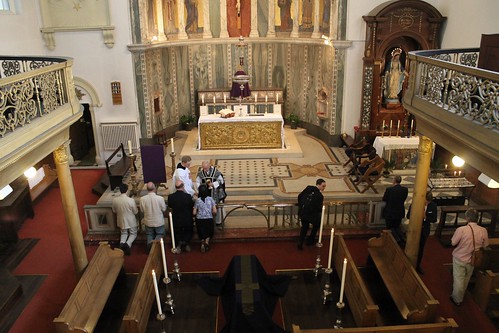 |
| Requiem for Michael Davies in 2015 in Warwick Street. |
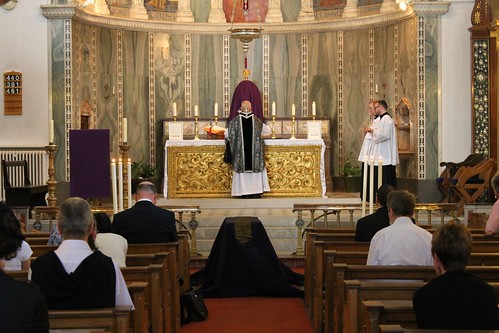
Support the work of the LMS by becoming an 'Anniversary Supporter'.
Juventutem London Mass on Friday 28th Oct
Support the work of the LMS by becoming an 'Anniversary Supporter'.
Amoris laetitia and the Bishops of Buenos Aires
I'm coming late to the party on this news, but I feel the need to think this through a bit by setting the matter out in a blog post. Everything in this post is, obviously, my personal opinion for which I don't claim any particular authority.
The saga of the interpretation of Amoris laetitia took a step forward with the publication of a letter addressed to priests from the bishops of the pastoral area of Buenos Aires, and the arrival in the public domain, somehow, of Pope Francis' response to that letter. This was an enthusiastic endorsement: 'The document is very good and completely explains the meaning of Chapter VIII of Amoris Laetitia,' he told them, adding: 'There are no other interpretations.'
The choreography of the letter and the Pope's response in the media leaves little doubt that the Pope wishes this to be seen widely as the correct interpretation of Amoris laetitia. I don't say it is an 'authoritative' interpretation since the Pope's letter to the bishops does not look like a magisterial act. What it does do, all the same, is give us a clearer take on Pope Francis' personal view than we have had up until now.
The key passage of the Bishops' letter is as follows. The possibility of a couple in an illicit union living in continence, as brother and sister, has just been raised. The letter goes on:
6) In other, more complex cases, and when a declaration of nullity has not been obtained, the above mentioned option may not, in fact, be feasible. Nonetheless, a path of discernment is still possible. If it comes to be recognized that, in a specific case, there are limitations that mitigate responsibility and culpability (cf. 301-302), especially when a person believes they would incur a subsequent wrong by harming the children of the new union, Amoris Laetitia offers the possibility of access to the sacraments of Reconciliation and Eucharist (cf. footnotes 336 and 351). These sacraments, in turn, dispose the person to continue maturing and growing with the power of grace.
It goes on to say that this concession should not be understood as of general application, but must follow from discernment and so on, and that the admission to Holy Communion might best be done in private.
To understand the significance of this we need to refer back to the passages of Amoris which are referred to, and clarify some of the operative concepts.
Mortal sin drives out sanctifying grace, which makes it impossible to receive Communion fruitfully. As I have discussed here, paragraphs 301-5 of Amoris about mitigating circumstances explicitly rule out of consideration the type of mitigation which can make an objectively gravely wrong action compatible with a continuing life of grace: viz., those factors which would stop the action being a mortal sin.
To be a mortal sin, an objectively gravely wrong action must be done with full consent of the will and with knowledge of its gravity. We can set aside the possibility that carnal relations between a couple in an illicit union are never engaged in with full consent, as if they were always intoxicated, victims of torture, or under the thumb of a cruel blackmailer. (These things are possible, but are not what Amoris has in mind.) The question comes down to knowledge of the moral gravity of the act. On this, Amoris (301) declares:
A subject may know full well the rule, yet have great difficulty in understanding “its inherent values”
This is important because as I have noted, the key type of case is that of 'churchy' people, who want to receive Communion, be godparents, and be on the Parish Council; people who in Germany and Austria pay the Church Tax. They cannot be said to be ignorant of the law: they know it 'well'; on the other hand they do not, subjectively, feel motivated to follow it -- they don't see 'its inherent values'.
Now, it is precisely because this type of case cannot be understood except as a mortal sin, that it has caused the problems it has. A couple who appear publicly to be in an illicit union but have managed to free themselves from the permanent state of moral sin by confession, and a firm purpose of living as brother and sister, can be given Communion in private, to avoid scandal to others. A person who, in the judgment of a confessor, has performed gravely wrong actions without full consent of the will or without knowledge of the gravity of the act, can be given absolution without a firm purpose of amendment, since he was never guilty of that particular mortal sin. These cases are not the problematic ones. The problematic case is that where the classical definition of mortal sin does apply, not one where it does not.
To take the matter forward we need to go beyond the text of Amoris, since the text does not, or at least not clearly, give us a solution to this problem. What we get is footnote 351, which appears in para 305, which I have discussed before. This says very simply that a person in an objective state of sin can be helped by the sacraments, which I took as a statement of the obvious. The sacraments exist to assist our salvation. The footnote says nothing about setting aside the normative conditions, set by Divine Law, for sacramental absolution or the fruitful reception of Communion. This, at any rate, was my 'pious' reading of the footnote in the light of the continuous teaching of the Church.
What the Argentine bishops have done is to take this reference to people being helped by the sacraments, in the context of a discussion of people in an on-going state of mortal sin (or: a subjective state which up to now would not allow a confessor to give absolution, or a pastor to give Communion even in private), and draw the conclusion that, since Amoris is telling us that such people should be helped by the sacraments, it follows that the rules (i.e. Divine Law) which govern the sacraments must be changed, or ignored, so that these individuals can receive the sacraments after all, without changing their own, subjective or objective, circumstances.
This of course is not new; it is the standard liberal interpretation of Amoris. What is new, or at least clearer than before, is that Pope Francis wants us to take this as the 'only interpretation' of Amoris. This fits in with his statement that Amoris makes a difference: it changes something. When asked if it did, he replied (on an aeroplane): 'I can say yes, period.' He then referred the assembled journalists to the interpretation of Cardinal Schönborn, who said, in an interview:
There is an evolution, clearly expressed by Pope Francis, in the Church’s perception of the elements that condition and that mitigate, elements that are special to our own epoch.
What the Argentine bishops' letter gives us is clear indication of exactly what the change is.
For the sake of completeness I should acknowledge that the supporters of the new discipline will say it is a matter of interpreting Divine Law, not changing it, and that Cardinal Schönborn made great play of the idea that the existing rules, in Canon Law and elsewhere, don't need to be changed because it was just a matter of realising that no rules could cover every case. These moves make no difference, however, since the perennial teaching of the Church, on such basic issues such as the nature of mortal sin, the Sixth Commandment, and the conditions for sacramental absolution, are perfectly clear and cover the disputed cases without any conceptual difficulties. It is precisely because these are not marginal cases that they can't be dealt with (to the satisfaction of those wanting change) using the resources of the existing rules and discipline, which has always allowed a role for the exercise of judgement by confessors and pastors, since the application of the law in hard cases is not a mechanical exercise.
We have here a difficult situation, to say the least, where at least a few points are clear.
1. As noted, the conditions under which a priest can absolve a penitent are set by Divine Law, since our Lord Jesus Christ established the sacrament and acts in it. No one seems to be suggesting that Confession be evaded, so this is a key sticking point. It is obvious that the Pope does not have the authority to change Divine Law.
2. The same is true of the fruitful reception of Holy Communion (determined by communicants' subjective state), and the duties of priests to avoid public scandal by giving public sinners Communion in public (determined by communicants' objective state). Theses things are set by Divine Law and can be changed by no human authority.
3. The Pope has not taught in a magisterial document that the Divine Law be changed, ignored, or radically reinterpreted, but he has made it clear non-magisterially that he wishes a magisterial document to be understood in that sense. This would not be a way of binding the consciences of Catholics even if Divine Law were not at stake. My 'pious' reading of footnote 351 noted above is still a possible reading of the document as a magisterial text, even if it is clear that my reading does not reflect Pope Francis' private views.
4. Although it is clear that what the Pope has indicated, in this roundabout way, is not correct, and not compatible with the teaching of the Church, there would be several more steps to go before we could say that the Pope is a heretic. Being a heretic involves stubborn adherence to error after the error has been pointed out by people with the appropriate authority. A process of 'warning' by, say, the College of Cardinals, and a subsequent reiteration of the error on the part of the Pope, would rule out possible misunderstandings of what this or that passage really means, on the part of both sides, give the Pope the opportunity to clarify or recant, and so forth. Such a process is quite unimaginable in the present historical situation of the Church. It just isn't going to happen.
5. What is going to happen is that some people will follow these hints of Pope Francis, and some will not. Time will go by and Amoris will remain an unclear magisterial document, and private letters of the Pope and interviews by Cardinal Schönborn will remain the expressions of private views.
6. The intensifying conflict and confusion will cause incalculable harm to souls.
Anyone, incidentally, who thinks that I have a record of interpreting Pope Francis in a hostile may want to read this.
Support the work of the LMS by becoming an 'Anniversary Supporter'.
LMS Pilgrimage to Wrexham
 There was a Missa Cantata at Wrexham Cathedral in Wales on Saturday for the LMS annual Pilgrimage to Wrexham in honour of St Richard Gwyn, a co-patron saint of the LMS.
There was a Missa Cantata at Wrexham Cathedral in Wales on Saturday for the LMS annual Pilgrimage to Wrexham in honour of St Richard Gwyn, a co-patron saint of the LMS.
The diocese of Wrexham is currently suffering considerable upheaval and church closures at the moment. It's great to see the Traditional latin Mass flourishing there.
Canon Scott Tanner was the celebrant and he brought with him a team of servers and singers from the Dome of Home.
The new LMS website is here!
Support the work of the LMS by becoming an 'Anniversary Supporter'.
Now there's an app to learn the server's responses at Mass!
 Highly recommended! Well done to Bill Redic and Una Voce Pittsburg for making this available.
Highly recommended! Well done to Bill Redic and Una Voce Pittsburg for making this available.This is a very specialized application - a training aid for servers of the Traditional Latin Mass. It provides a three-step aid to memorization of the Latin prayers and responses which a new server must master.
On the Memorize tab, all of the Latin prayers and responses, along with a phonetic pronunciation guide, are displayed. The new server must devote hours to the hard work of committing these prayers to memory.
On the Practice tab, the server hears a recording of a Priest and Server reciting the Latin prayers and responses. By reciting along with the Server, while following along with the written prayers, he becomes more familiar with them. Ten buttons allow easy repetition of particular prayers on the recording.
Finally, on the Test tab, the server tests his proficiency. The audio contains only the Priest's voice, and the new server must make all of the responses. By using the Pause button, he can get help with any prayer on which he is stumbling.
Children and the New Mass
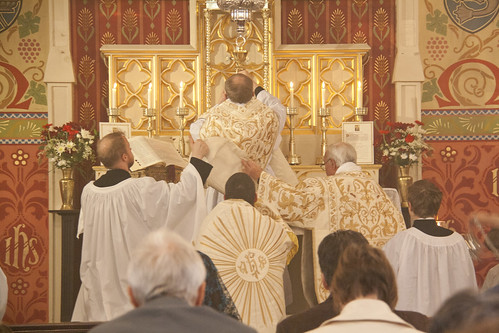 |
| Dull would he be of soul who could pass by / A sight so touching in its majesty. (Wordsworth) |
Continuing my theme of the last post, I can summarise what I have been saying in this way. Having an experience which one doesn't fully comprehend will lead to greater understanding, if it or similar experiences are repeated regularly, especially if, further, there are opportunities for asking questions from time to time, and other kinds of help. The liturgy is like this for children, but it is also like the experience of the emotional life of the family, since it evokes emotional and spiritual responses. Just as within family life, as children grow up they become more sensitive to emotional cues and more comprehending of others' needs, they also gain acuteness, from repeated experience, in the emotional and spiritual significance of the liturgy. There is a also a parallel in the special sensitivity very small children have to atmosphere.
The Novus Ordo Missae, and the attitudes which led to it, has created a problem in relation to children, because the leading idea of the reform was that worshippers should be able to understand the liturgy at a verbal level. That is the point of putting it into the vernacular, or having shorter and theologically simpler prayers, of getting the people to make more responses, and so on. Why is this a problem for children, you ask? Doesn't all this make it easier for children to understand? At a verbal level, the OF is indeed easier for children to understand. The problem is that if your conception of participation is verbal comprehension, then you have set yourself an impossible task in getting children, particularly small children, to participate. It doesn't matter how simple the language is. Some of the children at Mass can't even talk.
To repeat, the Ordinary Form is vastly, incomparably, better suited to immediate verbal comprehension than the Extraordinary Form. Not only does the latter use a non-cradle language, Latin, but even a worshipper who was a Latin prodigy would not be able to grasp the Canon or the Offertory at a verbal level as it goes along (without looking at a book) because they are said silently. This fact makes it obvious that immediate verbal comprehension is not the aim of the EF. Instead, it uses a range of verbal and non-verbal means to communicate something deeper than mere words, and does so with great effectiveness, just as the liturgy of the Eastern Churches does. The problem created by the OF is that, having set immediate verbal communication at the objective, and having removed the great bulk of the things which facilitate non-verbal communication in the EF, it is then faced with a category of worshippers with extremely limited, or indeed non-existent, verbal skills. Small children are never going to participate in the Mass in the way that the creators of the Novus Ordo wanted people to participate: with immediate verbal comprehension.
The response of the promoters of the liturgical reform was twofold. First, they tried to make the language even easier: having set out to create a Eucharistic Prayer which is 'short and very simple in its ideas', viz. EP2, they realised this was still far too difficult for children, so they created special Eucharistic Prayers for them. Other adaptations to the liturgy when offered for children are also recommended in the Directory for Children. The result of course can be a liturgy quite unbearable for adults, but in any case small children will, still, hardly understand a word of what is going on.
The Directory for Children is very concerned about children bing bored. So the second prong the response is to take children out of the liturgy altogether, at least for a large chunk of the Mass, and to give them some kind of para-liturgical experience instead. Many of these are hideous in every way; no doubt others are well-constructed and reverent. But they don't and can't solve the problem, because although there is even more flexibility about the language used, verbal comprehension is always going to be difficult or indeed impossible with children with little or no verbal capacities. At the same time, the informality of these para-liturgies moves us even further away from the techniques of non-verbal communication which work so well in the EF.
In other words, the means adopted to make the liturgy easier to understand by children are digging us deeper and deeper into the hole. Adopting simpler and simpler language in a more and more informal structure, makes it harder and harder for the children--or for anyone--to pick up non-verbally the sacred realities taking place in the liturgy. But with children, particularly small children, such non-verbal cues are the only way of engaging them, because they have limited or actually no ability to use words.
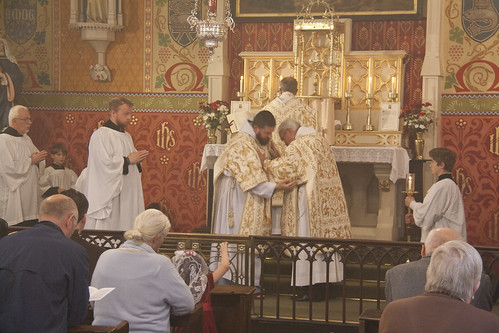 |
| You have to be highly educated to think that this is not an eloquent symbol. |
It doesn't matter what you say to a two-year old, and it makes little difference what you say to a five-year-old, or even an eight-year-old or to many fourteen-year-olds: they are not going to grasp any kind of extended liturgical text verbally, particularly if they have not heard it lots of times before. As a matter of fact, I don't think that I myself would be able to grasp an unfamiliar Eucharistic Prayer, in real time as it was declaimed from the Altar: that is actually quite a demanding task. What children can, in time, come to appreciate, is the grandeur of a procession, the beauty of chant, and the special significance of the Elevation--if, of course, these are allowed to be grand, beautiful, and special.
Let me make the same point from another perspective. In the EF, there is great formality in what is going on in the sanctuary, and considerable informality about what is going on in the nave. There are no binding rules for the laity to stand and sit and kneel. There are few responses, and there is no pressure to make them. People are free to say their own prayers.
In the Novus Ordo, the situation is reversed. The solemn formality of the sanctuary has been considerably downplayed, and many priests do their best to make things look spontaneous even when they are not. In the nave, it is another matter. The laity can even be barked at to stand, sit, kneel, make responses, hold hands, sing songs, and so on. Their outward liturgical participation is controlled: spontaneity is forbidden.
What of children in the two settings? In the first, they can move around with less chance of disturbing others, because there is no elaborately choreographed activity going on among the congregation. On the other hand, the stuff going on the sanctuary is deeply interesting from a visual point of view, and will become embedded in their imaginations precisely because it is predictable and repeated. Furthermore, it creates a powerful atmosphere of quiet and awe, which children are well adapted to absorb.
In the second, there is pressure to take part, if not in the main congregation's activities, then in special activities for the kiddies in the Children's Liturgy. Children are systematically prevented from thinking their own thoughts, or absorbing what is going on at their own pace, in their own way. Then again, there is much less to see, and what there is does not fall into such well-defined patterns; it is less dramatic, less vivid, and isn't repeated week by week in the same way. The sense of the sacred, the 'sacrality', everyone seems to agree, is less pronounced.
Which is better suited to the participation of children? I think the answer is obvious.
To summarise the matter, the kind of participation proposed to the laity in the Ordinary Form is less suited to children.
This is a particular application of a more general point, which I have made before on this blog. It is commonly observed that the less educated, and men, are less readily engaged with words, and this is part of why, as Anthony Archer argued, the Catholic Church lost its English working-class backbone after 1970; it is also part of why Novus Ordo congregations are skewed towards women, and EF congregations are more balanced between the sexes. The problem arises even more acutely with groups of Catholics for whom the vernacular used in the liturgy is not their mother tongue.
The Novus Ordo was composed by, and for, highly articulate, intellectual, educated, middle class individuals, who managed to persuade themselves that what they were doing was going to be quite marvellous for the simple folk, the missions (where vernacular Masses are frequently not in the language of the people present), and for children, because it was all going to to be simple.
Simple things for simple people. Well these 'simple people' may even have been better equipped than the patronising middle class educational elite to pick up the symbolic and atmospheric cues of the ancient liturgy: the anthropologist Mary Douglas argues this in all seriousness. What they are not so good at is this precisely this verbal stuff.
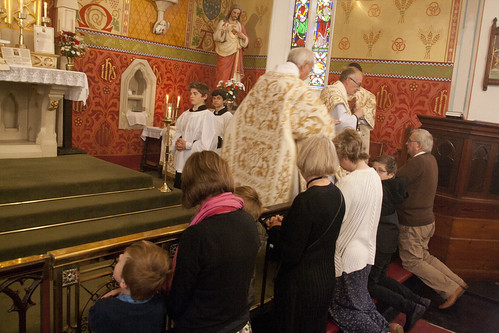 |
| Photos: High Mass in Holy Trinity, Hethe. |
Support the work of the LMS by becoming an 'Anniversary Supporter'.
Children at Mass
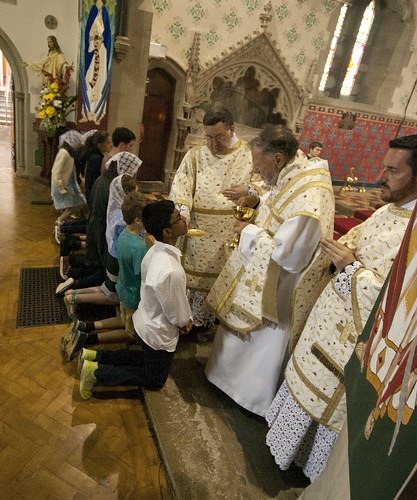 |
| At the St Catherine's Trust Summer School |
Seeing this post on the internet, by a Protestant about children's liturgies, which makes some good points, has stimulated me to attempt to put my thoughts into order about children at Mass. However this process is still at an early stage...
I have written on this blog about how the 1974 Directory on Children explicitly promoted the idea that children should be introduced to the liturgy through 'human values', and expected them to 'open their eyes' to the supernatural nature of the liturgy only at a later stage. I think this idea is the source of a large proportion of the confusion and mistakes which are found in the debate today. It seemed to me to parallel Maria Montissori's argument that young children are not ready for fairy stories, because they cannot distinguish fantasy and reality. It is also related to the idea we find in the Liturgical Movement, that 'understanding' is necessary to participation in the liturgy. If 'understanding' is a matter of being able to articulate the message being conveyed, then this is a argument for a drastic simplification of the liturgy, a simplification which must go even further when the liturgy is being offered to the 'simple', and to children. This is exactly the pattern we see in progressive liturgical talk, so I think this must be what they are thinking, or something like it. The poor and uneducated cannot understand complicated theology, give them something simple, they say.
Now this of course is a terrible mistake. To see it is a mistake, just think of wordless prayer: the kind of prayer used by the Church's saints and mystics, to which we are all encouraged to aspire. (The Catechism of the Catholic Church has a magnificent section on prayer which says a lot about this.) A person who engages in wordless prayer, is he able to articulate, to put into words, the propositional meaning for his experience? Of course not. Does that mean that he failed to participate in this practice, or failed to communicate? Far from it.
The same point can be made in relation to the appreciation of art. Do you need to be able to articulate, put into words, what you gained from an encounter with a great work of art, for it to count as a meaningful experience? Don't be daft.
A different brand of progressive in the Christian world is very against propositional, intellectual, linear, logical, theology. Quakers, for example, don't do a great deal of logic-chopping in their theological reflections, and have wordless, silent worship to go with it. The Catholic tradition combines mysticism with intellectual rigour - quite an achievement, when you think about it. It is the liberal achievement to destroy both at the same time, which is equally impressive, though in a different way...
Anyway, once we free ourselves of the unfortunate idea that people don't get anything out of an experience when they can't write down it's meaning in a series of propositions, then we can think about a whole lot of things in a more sensible way. The relationship a parent can have, for example, with a Down's Syndrome child. The wordless companionship of those in love. The social experience of interactive sports. The world really is an interesting place, if you don't limit communication to words, and meaningful experiences to things which can without remainder be put into words: we all know this, if we don't let liturgical maniacs befuddle us.
Accordingly, there is no reason to assume that small children don't get something out of the liturgy, and it is misleading to say that they do not understand it. Understanding a complex experience is a matter of degree, and small children understand things at their own level, in their own way, and gradually come to understand more, if they keep on having similar experiences. That's how they learn. It no more makes sense to say 'they shouldn't be at Mass (or: the normal Mass) because they don't understand', than it makes sense to say that they shouldn't be exposed to adults talking to each other, or paintings, or school work, or loving relationships. How are they ever going to understand it, if they are not exposed to it?
To take this to a deeper level, I want to note three categories of experience children have.
The first is in relation to things that particularly appeal to them. Children can pay very close attention to stories, and on occasion remember them in great detail. They can be fascinated by farm or wild animals. And of course they can be completely absorbed in play. These examples show children's considerable capacity for concentration. Perhaps this doesn't happen to children whose brains are addled with TV, but for non-pathological youngsters it does.
The second is with things which might be said to be 'over their heads'. If you take small children to an art gallery, or let them play in the same room where adults are talking, or expose them to any number of things which are, in an obvious way, over their heads, what you find is this. They will do their own thing - look at their books, draw, play with dolls or whatever - and attend to the art, or the conversation, or whatever adult thing is at issue sporadically. From time to time they may catch sight of or hear something which engages them, and ask a question, or just pay attention to it. This can on occasion take the form of prolonged concentration. You may find out days or weeks later that a child has been thinking intensely about some remark he heard in an adult conversation, and it may have been the subject of discussion in a group of children. The child may stop in the art gallery and stare at a particular picture for a long time. It may put in an appearance in his dreams.
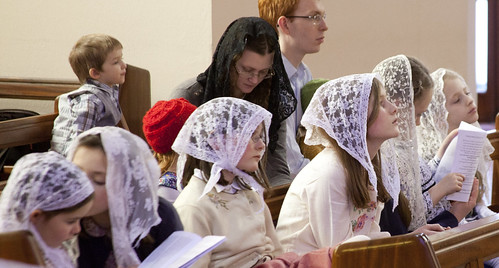 |
| At the St Catherine's Trust Family Retreat |
As time goes on, this sporadic attention to the grown-up material becomes more frequent, as successive linguistic and conceptual barriers to engagement are overcome. Children grow up. It is important to recognise that the period of sporadic engagement with adult conversation, with art, or whatever it might be, is normal, not necessarily boring for the child (who needn't be prevented from allowing his mind to wander), and part of the process of development. The way some educationalists talk, we might imagine that children should be quarantined from the adult world until systematic classroom teaching has equipped them to take part in it as an equal. That is the last thing, of course, which classroom education is capable of equipping a child to do.
The third category of experience works in a slightly different way: relationships. Children don't learn about love and friendship, anger, resentment, forgiveness, rivalry and cooperation, by taking notes from a blackboard. These are things which are not necessarily articulated at any point in one's life; a fully functioning adult, with sensitivity and good social skills, cannot put his wisdom fully into words, because that would be impossible, and greater 'emotional intelligence' doesn't necessarily imply a greater than average ability to articulate it. This is an understanding which is learnt from experience and example, experiences and examples which do not (primarily) convey propositions, but enter into a child, and effect his character. You can see children, and adults too, becoming more sensitive and more generous, or harder, more pinched and selfish, as time goes on. You can see it in their behaviour, and in their faces. It's not, primarily, a matter of their accumulating knowledge, it is matter of character formation.
Again, my point is that this is normal, and that this is an immensely important aspect of education--for want of a better word--which has nothing to do with formal education.
What I want to suggest is that while the liturgy is not normally like the first kind of experience, it is a bit like the second--engagement with things 'over their heads'--and a bit like the third--a child's education in relationships--and indeed these two kinds of experience are not completely different from each other. A child's liturgical experience is at once a matter of sporadic attention to what is grown up, but also something which has an emotional and spiritual impact on the child's developing character. The little things which a small child may happen to notice in Mass--a bit of chant, a beautiful vestment, the Infant Jesus in the crib--may not only be the subject of intense interest, but in small ways formative influences. As a child's attention to the liturgy becomes less sporadic, he will find that what he is now paying closer attention to is something with which he is already thoroughly familiar, as is the case with adult conversation or the pictures on the walls of his own home. This familiarity is a school of prayer, just as the emotional life of the family is a school of relationships.
The children of Catholics attached to the Traditional Mass are not preternaturally disinclined to run (or crawl) up and down, bang toys on pews, and pull each other's hair. They don't pay attention to everything the priest says and does from the moment of their baptism. They gain a useful training in being quiet and respectful, of course, by attending Mass with their parents. But the fundamental thing is that they gain a familiarity with the most beautiful and profound spiritual things, in a context of reverence of course, and not only does this lend itself to a growing understanding, in every sense, of what is going on, but it affects the development of their personalities. Liturgical hierarchy, order, and worship; the reality of holy things, and how they can be handled; the ordering of joy and grief and penance and praise into the prayer of Christ in the Church: these things can't be taught from a book, and they can't be picked up in a few weeks. They must gradually take form inside a receptive soul exposed to the liturgy over years and decades.
Like almost every Catholic of my generation, I was deprived of our great liturgical patrimony as a child. Even so, my early experiences of the liturgy had an effect on me, and not all bad. As well as some ghastly things, I have deep and moving memories of Midnight Masses, early morning Masses, monastic Vespers, the singing of the Ave Regina Caelorum: these stray things stayed with me and nourished my imagination and soul. What a privilege it is, now, to be able to take my own children to Mass. Without deprecating liturgical catechesis, discussing the readings and all that, the main message must be: Just let them soak it up.
And for heaven's sake don't take them away from grown-up worship in order to give them something 'easier to understand'.
Support the work of the LMS by becoming an 'Anniversary Supporter'.


